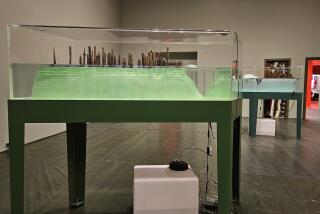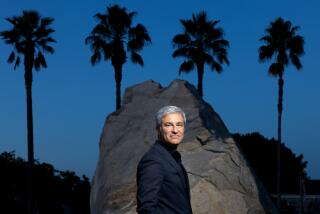MOCA’s past and future
- Share via
In the wake of Paul Schimmel’s departure as chief curator at the Museum of Contemporary Art, much has been written about the museum. Given my long-standing relationship with MOCA, I would like to provide some background about the museum in an effort to set the record straight.
In 1979, Los Angeles lacked a modern and contemporary art museum. Artists and collectors talked about starting a museum for years, but they couldn’t make it happen. I was the founding chairman of the board of trustees at MOCA and was pleased to join with several others in creating the museum by persuading Mayor Tom Bradley to aggregate the funds developers were required to pay for art. He agreed to use the money to create MOCA’s Grand Avenue building if we could raise $10 million for an endowment. We succeeded in raising $13 million from 600 founders — in today’s dollars, that amounts to $36.26 million.
MOCA had an auspicious beginning. We recruited Pontus Hulten from the Pompidou Center and Richard Koshalek as deputy director and chief curator. We opened the Temporary Contemporary (now the Geffen Contemporary) in 1983 and the Grand Avenue building in 1986.
We had the support of a stellar group of local and international trustees. Annual attendance in the early years was about 250,000 — long before thousands of people lived and worked downtown and years before L.A. Live, the Cathedral of Our Lady of the Angels and the Walt Disney Concert Hall were built.
All was well going into the 1990s. Up to that point, we had a number of world-class exhibitions curated by Hulten and Koshalek — shows that received critical acclaim. Under their curatorial leadership, we acquired a great collection including some of the very best works by Mark Rothko, Robert Rauschenberg, Jackson Pollock, Franz Kline, Claes Oldenburg, Alberto Giacometti and other 20th century masters.
After serving 14 years, I left the board of MOCA in 1993 when the budget was $7.5 million. When Koshalek left in June 1999 to become the director of Art Center College of Design in Pasadena, MOCA had an endowment of about $40 million ($55.2 million in 2012 dollars).
In the succeeding years, MOCA’s annual expenses spiraled out of control, rising to an annual budget of $24 million. Its staff swelled to twice the size of its peer institutions. Attendance dropped to a low of 148,000, and MOCA dipped into its endowment to fund its operating expenses, drawing down the endowment to $5 million. Had MOCA’s endowment been properly invested, and had it not been raided, it could have amounted to about $100 million today. When the Broad Foundations stepped in with a $30-million grant, including a $15-million challenge grant, at the end of 2008, it was to save MOCA.
We were fortunate to persuade former UCLA Chancellor Charles E. Young to step in as chief executive on an interim basis to start to straighten things out administratively and financially. After 18 months, it became clear to the board that it needed a director who could create exhibitions that would dramatically increase attendance and membership and make MOCA a populist rather than an insular institution. After an extensive search and interviews with 10 candidates, the board wisely chose Jeffrey Deitch.
At the end of 2008, MOCA had a contentious culture, and a number of trustees had resigned. Those who stayed on the board couldn’t agree on the future direction of MOCA. Since Deitch’s arrival, the culture at MOCA has improved dramatically. A number of new trustees joined the board, infusing much-needed energy and fiscal discipline. It took some time to get the right team in place. MOCA now has a strong chief operating officer in Michael Harrison and a good development operation. And with the recent personnel changes, Deitch and the board expect the team to work together more effectively. By demonstrating that MOCA has a prudent financial and exhibition plan, the museum is expected to attract an even greater number of members, trustees and donors.
MOCA’s endowment is now pushing $20 million; next year its budget is $14.3 million, and in 2011, attendance was more than 400,000 — 2 1/2 times what it was when the budget was $24 million.
Over the years, MOCA has mounted many great exhibitions. However, the museum has also curated a number of exhibitions that were costly and poorly attended, often exceeding $100 per visitor. In today’s economic environment, museums must be fiscally prudent and creative in presenting cost-effective, visually stimulating exhibitions that attract a broad audience.
There has been much confusion about Schimmel’s departure. For several years, he’s been contemplating a change and has been a candidate for a number of positions at other institutions. Schimmel is a brilliant curator, but the board members recognized the director’s right to put his own team together. When they accepted Schimmel’s resignation, they acknowledged that he has left an indelible mark on MOCA’s history during his 22-year tenure. They look forward to continuing to work with him — together with guest curators from around the world — to develop the world-class exhibitions that MOCA is known for. They also look forward to MOCA showing more of its permanent collection — 80% of which has not been seen in the last 10 years.
Museums around the country are cutting their hours or facing such severe financial deficits that they risk closure, like the Corcoran Gallery of Art in Washington.
MOCA recognizes its mission to serve the public and is maintaining its hours. Museums across America have had to reduce their staffing levels. MOCA is no exception.
MOCA does not receive government funding, unlike LACMA. The board has a fiduciary responsibility to take the necessary action to ensure a balanced budget.
I applaud the decision of MOCA’s director, board leadership and board in right-sizing the staff and adopting a budget that they expect will be balanced in the coming year and in future years.
I am confident that with Deitch’s leadership and with the board and its leadership, MOCA will thrive and will avoid the problems that are plaguing other institutions while increasing attendance and membership, continuing to offer world-class exhibitions, and exhibiting its collection.
Eli Broad is founding chairman and life trustee of the MOCA board of trustees.
More to Read
A cure for the common opinion
Get thought-provoking perspectives with our weekly newsletter.
You may occasionally receive promotional content from the Los Angeles Times.










